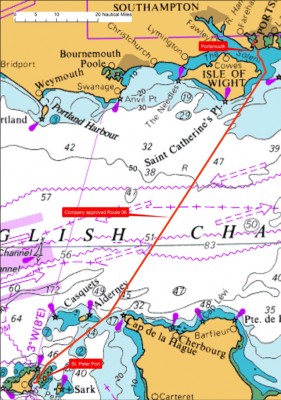The Marine Accident Investigation Branch (MAIB) has published the findings of an investigation into the grounding and flooding of the ro-ro ferry Commodore Clipper, at St Peter Port in Guernsey last year.
At 1515 on 14 July 2014, the Bahamas-registered ro-ro passenger ferry grounded on a charted, rocky shoal in the approaches to St Peter Port, Guernsey.
No-one was injured, there was no pollution and the vessel continued its passage into the harbour. However, there was significant raking damage including breaches of the hull resulting in flooding of double-bottom void spaces.
The grounding caused a noisy, shuddering vibration that reverberated throughout the ship, but the crew did not check for damage, no external report was made and no safety announcements were made to the passengers.
Once alongside in St Peter Port, cargo discharge, reloading and a lifeboat drill went ahead as planned. However, a pre-planned divers’ inspection of the hull soon discovered damage and the vessel was withdrawn from service.
‘Insufficient passage planning’
The MAIB investigation found that there had been insufficient passage planning for the voyage; in particular, for the transit through the Little Russel, the extremely low tide and effect of squat were not properly considered.
This resulted in the bridge team being unaware of the limits of safe water available and thus, despite their good positional awareness, they headed into danger without appreciation of the risk.
Several course alterations intended to regain track were ineffective due to the tidal stream setting the vessel off course.
Additionally, the absence of any alarm, steering and propulsion responding normally, and the master’s conviction that there had been sufficient depth of water, led to a collective denial of the possibility that the vessel might have grounded.
The company’s approved route for use through the Little Russel was not followed and the vessel’s electronic chart display and information system was not utilised effectively because key safety features were either disabled or ignored.
It was also established that Guernsey Harbours did not have an effective safety management system for the conduct of pilotage within its statutory area.
Safety recommendations have been made to Condor Marine Services Limited and the
Government of Guernsey designed to ensure appropriate levels of proficiency in the
conduct of safe navigation.
Conclusions
The MAIB report concludes: ‘Had all the factors affecting under keel clearance been accurately assessed, it would have been apparent that it was potentially unsafe to pass over any charted depth less than 7.5m in the Little Russel.
‘The absence of sufficient passage planning meant that the bridge team was unaware of the limits of safe water so approached danger without appreciating the hazard. Furthermore, a safer course of action was available – use of the wider Big Russel channel.
‘Course alterations intended to regain track were insufficient given the strength of the tidal stream setting Commodore Clipper off course.
‘The highly repetitive nature of Commodore Clipper’s schedule induced a degree of planning complacency.’
Read the full report on the MAIB website.
Related articles
- Grounded yacht sparks two rescue missions – 40 miles apart
- Grounded catamaran skipper airlifted from boat
- Sailors airlifted from grounded yacht
- Three rescued from grounded yacht
- Grounded yacht skipper praises rescuers
Actions taken
Several actions have been taken since the incident, including an investigation into the grounding by Condor Marine Services Limited with the causal factors identified and the report circulated to other command teams.
The company has also imposed a minimum 4.0m height of tide restriction for conventional vessels using the Little Russel; undertaken a study of the interaction characteristics of all its vessels, leading to publication of advice to masters on the calculation and application of squat and fitted an ECDIS repeater display at the chief officer’s position on board Commodore Clipper.
There is a plan to install bilge alarms into Commodore Clipper‘s double-bottom void spaces during the next refit period.
Meanwhile, Guernsey Harbours has established a routine for St Peter Port harbour control watchkeepers to transmit tidal and weather information by VHF radio to inbound vessels prior to entering the pilotage area, and procured and installed a new remote tide gauge system among other measures.






